Southern Rust Update
Southern corn rust (Figure 1) has now been confirmed in more than a dozen Nebraska counties (Figure 2) in eastern and south central Nebraska. The furthest north the disease has been confirmed is Antelope County in northeast Nebraska. This is an indicator that this disease is likely also in areas of Nebraska that haven’t been confirmed yet. The disease is still at low incidence and severity in most of these counties and not requiring treatment. However, after several days of warm, humid weather it significantly increased in severity in some localized areas of extreme southeastern Nebraska and fungicide applications were necessary.
In some of these fields it was first confirmed about two weeks ago followed by very favorable weather conditions. The disease is likely elsewhere and fields, particularly in southern and eastern Nebraska counties, should be scouted now and frequently for disease in the coming days and weeks. Spores will continue to blow into our state from Kansas and Missouri for several weeks, leading to continued disease development in new fields and the need for fungicide applications in some fields.
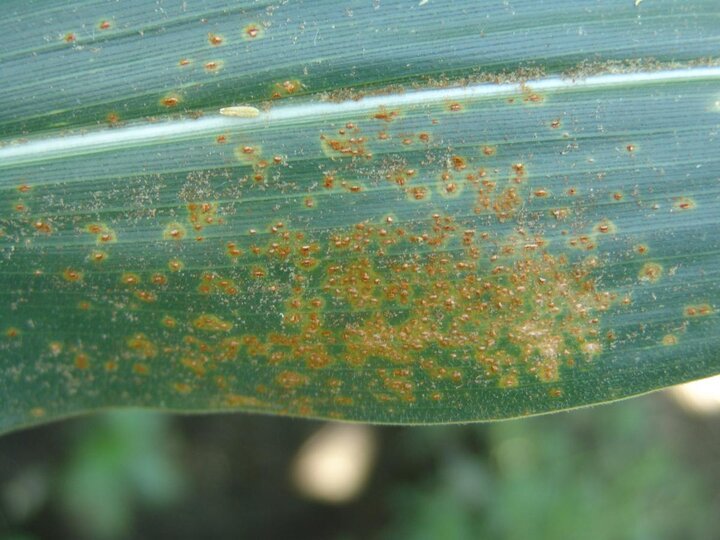
Southern rust is caused by an aggressive fungus that can cause disease in as little as a few days on susceptible corn hybrids and under favorable weather conditions. The disease can cause significant yield loss in susceptible hybrids if it becomes severe, so producers and crop advisors should be closely monitoring fields. In the most severe cases in southern states where the disease is more common, yield loss in susceptible hybrids has reached almost 50%. In most years severe southern rust is uncommon in northern, more temperate states like Nebraska; however, significant yield impacts have been observed in some areas of the state when severe disease outbreaks occurred prior to or during early grain-fill stages.
Warm, humid weather conditions are favorable for disease development and spread. The pathogen does not overwinter and so its spores (urediniospores) must be blown into the area by wind from the south. The fungus needs moisture to germinate and infect, so high relative humidity, rainfall, irrigation, etc. will hasten disease development. Warm temperatures also favor southern rust development, especially temperatures in the upper 70s to lower 80s F, which are optimal for the fungus. It doesn’t matter when these temperatures occur – daytime or overnight.
Monitoring and Management
A Nebraska map (Figure 2) showing counties with confirmed southern rust disease will be updated as new outbreaks are confirmed. (Follow updates at cropwatch.unl.edu/2017/2017-southern-rust-map.) In addition, a new national southern rust tracking website has been created to help document the distribution of the disease. Please help us keep the map updated by sharing samples and photos of the disease. Samples submitted to the UNL Plant and Pest Diagnostic Clinic that are microscopically confirmed will be highlighted in red, while other samples that look probable for southern rust in photos will be highlighted in yellow to indicate that the disease is “suspected” until a positive sample is submitted from that county.
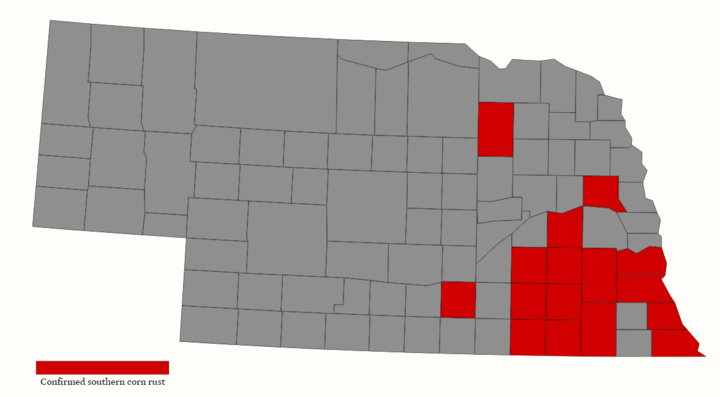
Most hybrids planted in temperate areas are susceptible to the southern rust fungus. Foliar fungicides can effectively manage the disease. Most systemic fungicides can provide protection of leaves from future infections for 21-28 days.
The wide range of planting dates across Nebraska this year has resulted in a wide range of corn growth and reproductive stages. Later planted fields that are earlier in their maturity are at the greatest risk for yield loss if the disease develops there soon. Southern rust can take days to several weeks to develop once it’s identified in an area, so immediate treatment may not be necessary for most fields. Spraying early may mean a second application is necessary later in the season to protect plants during later grain-fill stages as the disease increases in severity once fungicides have worn off.
Bacterial Leaf Streak
Bacterial leaf streak (Figure 3) has continued to be a significant disease in 2017 in some of the same areas of Nebraska where it was previously observed. The disease has increased in severity in some fields, often moving further up the plant into the upper leaves. With the increasing incidence of gray leaf spot fungal disease now, it’s important to familiarize yourself with the symptoms of both diseases and clues on how to differentiate them.
With bacterial leaf streak narrow brown to orange streaks or stripes develop between leaf veins and can be short (
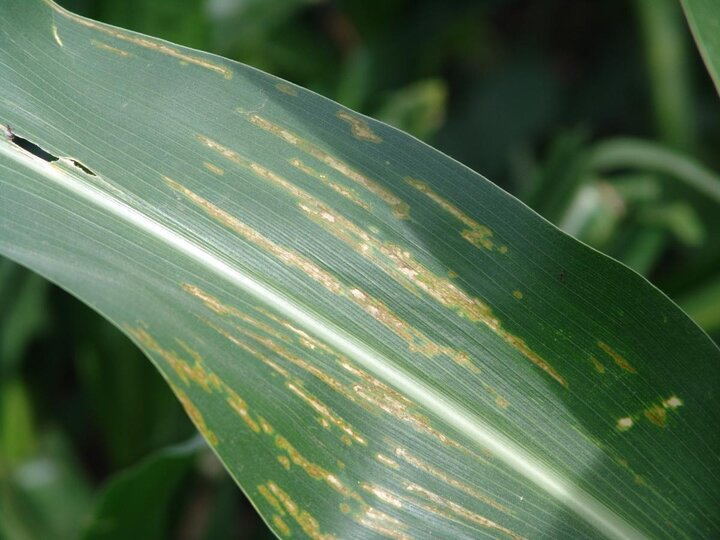
Diagnosis and Management
Diagnosing the disease in the field may be difficult because it appears similar to some other diseases and because the bacteria causing it is not visible by sight or even with some microscopes. Some hybrids may produce lesions very similar to those of gray leaf spot. However, gray leaf spot lesions may more commonly have straight, smooth margins, in contrast to bacterial leaf streak which often has wavy leaf margins. It is possible to have this and other diseases such as gray leaf spot on the same sample, further complicating diagnosis. For a diagnosis, we recommend and request submission of samples of this bacterial disease to the UNL Plant and Pest Diagnostic Clinic.
Because the disease is caused by a bacterial pathogen, we do not expect foliar fungicides to directly control it. Some bactericides, such as those containing copper, are labeled for use in corn, but their effects have not been studied on this disease. Activity of bactericides are often different from that of foliar fungicides. For example, most bactericides are contact products and not systemic, so they won’t be absorbed by plants, in contrast to many common foliar fungicides. Thus, bactericides may be washed off with rain or overhead irrigation and may require repeated applications for control, making them uneconomical or impractical for use in some corn crops. Other common pest management strategies, such as crop rotation, may be helpful but the host range of this pathogen is currently unknown.

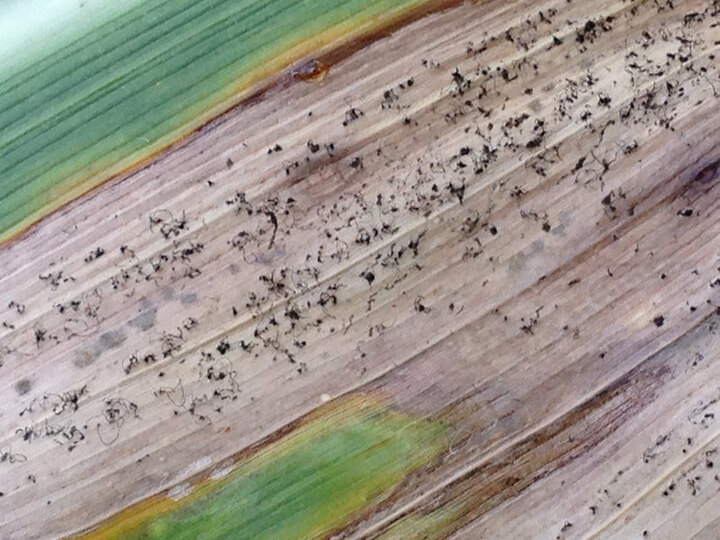
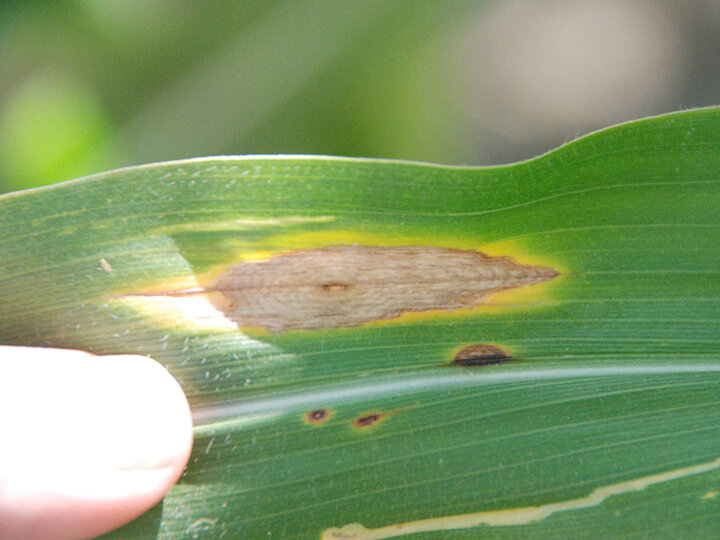
Diplodia Leaf Streak
Diplodia (Stenocarpella) leaf streak (Figure 4), caused by the fungus Stenocarpella macrospora (syn. Diplodia macrospora and S. zeae) has been confirmed in samples from Madison and Platte counties in eastern Nebraska. This fungal disease had previously been identified in several other states, but this is the first time it has been confirmed on corn samples from Nebraska.
Disease symptoms are similar to those of several other common diseases, making it difficult to recognize. For example, the large tan lesions caused by Diplodia leaf streak may look similar to the large lesions of northern corn leaf blight or Goss’s bacterial wilt and blight. Lesions may begin as small elliptical tan to brown spots expanding into very long streaks that usually have tapered, pointed ends. Fungal reproductive structures, called pycnidia, may develop within the lesions. These pycnidia look like black dots and release two-celled spores on the surface. The fungus survives in infested plant residue, in the soil, or on seed. Infection and disease development is favored by warm, wet conditions. Disease primarily occurs on the leaves and is related to the fungus causing Diplodia (Stenocarpella) ear rot. Because the fungus primarily survives in infested residue, the most effective management strategies in other states have been crop rotation and tillage as resistant hybrids are not available. The disease has been largely considered a minor disease in other states where it occurs.
Sample Submission
For help identifying diseases you’re seeing, submit samples to the UNL Plant and Pest Diagnostic Clinic. Click here for more information on how to submit a sample and the sample submissions form.
Resources
For more information on these or other diseases see the Corn Disease section of CropWatch. Information on other corn diseases also may be helpful in differentiating them and determining whether treatment would be appropriate.

